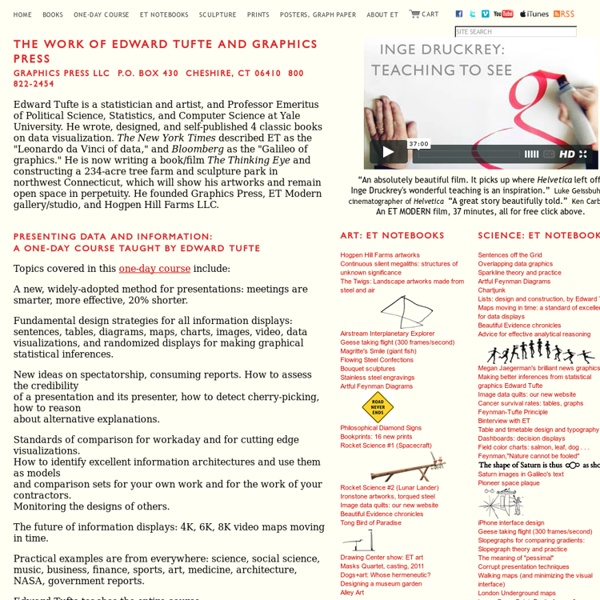SAS enables visually impaired to 'visualize' data
Source: SAS Cary, NC (Feb 22, 2017) People with visual impairments are often shut out from hot careers in STEM fields, including analytics and data science.
Data visualization
Data visualization or data visualisation is viewed by many disciplines as a modern equivalent of visual communication. It is not owned by any one field, but rather finds interpretation across many (e.g. it is viewed as a modern branch of descriptive statistics by some, but also as a grounded theory development tool by others). It involves the creation and study of the visual representation of data, meaning "information that has been abstracted in some schematic form, including attributes or variables for the units of information".[1] A primary goal of data visualization is to communicate information clearly and efficiently to users via the information graphics selected, such as tables and charts.
A List of 20 Free Tools for Teachers to Create Awesome Presentations and Slideshows
Below is a list of some of the best free tools teachers and students can use to create awesome slideshow and presentations. 1- KnovioKnovio gives life to static slides and with a simple click you will be able to turn them into rich video and audio presentations that you can share with your friends and colleagues via email or popular social media websites. Knovio does not require any software installation or download, it is all web based. 2- AheadAhead is a great presentation tool for educators.
Data Viz for the Visually Impaired - Part 2: Colour Blindness - E-Tabs
Following from our previous blog post on how to design visualisation for the visually impaired, we now turn our attention to how best to accommodate colour blind viewers. As many as eight percent of men and 0.5 percent of women with Northern European ancestry have the common form of red-green colour blindness. Men are much more likely to be colour blind than women because the genes responsible for the most common, inherited colour blindness are on the X chromosome.
Information visualization
Graphic representation of a minute fraction of the WWW, demonstrating hyperlinks Information visualization or information visualisation is the study of (interactive) visual representations of abstract data to reinforce human cognition. The abstract data include both numerical and non-numerical data, such as text and geographic information. However, information visualization differs from scientific visualization: "it’s infovis [information visualization] when the spatial representation is chosen, and it’s scivis [scientific visualization] when the spatial representation is given".[1]
Data Viz for the Visually Impaired - Part 1: Partially Sighted - E-Tabs
Data Visualisation is all about visualising data. Whether it is a chart in a report, an infographic or a dashboard– the key point is that it is visual! Visual: ˈvɪʒjʊəl,-adjective – Relating to seeing or sight. So can we deliver a visual representation of data to a person without perfect vision? If so, how can we provide this person the best visualisation? Is there even any reason to cater for such individuals in the first place?
Patent visualisation
Patent visualisation is an application of information visualisation. The number of patents has been increasing steadily,[1] thus forcing companies to consider intellectual property as a part of their strategy.[2] So patent visualisation like patent mapping is used to quickly view patents portfolio. Patent visualisation dedicated software began to appear in 2000 like Aureka from Aurigin now owned by Thomson Reuters.[3] Many patent and portfolio analytics platforms, such as Relecura, Innography and Patent iNSIGHT Pro,[4] offer options to visualise specific data within patent documents by creating Topic Maps,[5] Priority Maps, IP Landscape reports[6] etc. Patents contain two types of information: Structured data like publication number which are processed by data-mining and unstructured text like title, abstract and claims which are used with text mining.[9] Data mining[edit] The main step in processing structured information lies on data-mining.
Data Visualization and the Blind
Recently, I received an email from a fellow name Mark Ostroff who has written a guide to designing “accessible” content using the Oracle Business Intelligence Suite (OBIEE). In particular, the guide addresses issues regarding impaired vision, such as colorblindness and total blindness. Despite the fact that Mark began by saying that he and I “could be ‘twins separated at birth’ in our orientation about business intelligence,” by the second email in our conversation it became clear that he had a bone to pick. He accused me of shirking my responsibility by not teaching people to design information displays in ways that are accessible to the blind—dashboards in particular. Actually, his accusation was a bit harsher. He suggested that, by failing to teach people to design dashboards in ways that were accessible to the blind, I was encouraging my clients to break the law.



